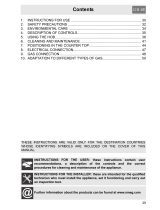
Use
62
Main oven functions
Static
As the heat comes from above and
below at the same time, this system
is particularly suitable for certain
types of food. Traditional cooking,
also known as static cooking, is
suitable for cooking just one dish at
a time. Perfect for all types of roasts,
bread and cakes, and in any case,
particularly suitable for fatty meats
such as goose and duck.
Fan assisted
The operation of the fan, combined
with traditional cooking, ensures
consistent cooking even with
complex recipes. Perfect for biscuits
and cakes, even when
simultaneously cooked on several
levels. (For multiple-level cooking,
we recommend using the 2
nd
and
4
th
shelves).
Small grill
Using only the heat released from
the central element, this function
allows you to grill small portions of
meat and fish for making kebabs,
toasted sandwiches and any types
of grilled vegetable side dishes.
Fan with grill
The air produced by the fan softens
the strong heatwave generated by
the grill, grilling perfectly even very
thick foods. Perfect for large cuts of
meat (e.g. shin of pork).
Fan + lower element
The combination of the fan with just
the lower heating element allows
cooking to be completed more
rapidly. This system is
recommended for sterilising or for
finishing off the cooking of foods
which are already well-cooked on
the surface, but not inside, which
therefore need a little more heat.
Perfect for any type of food.
In pyrolytic models, the special
defrost and proving functions are
brought together under the same
function.
Lower element + fan with circulaire
Fan-assisted cooking is combined
with the heat coming from the
bottom and allows you at the same
time to slightly brown food. Perfect
for any type of food
Fan with circulaire
The combination of the fan and the
circulaire heating element
(incorporated in the rear of the
oven) allows you to cook different
foods on several levels, as long as
they need the same temperatures
and same type of cooking. Hot air
circulation ensures instant and even
distribution of heat. It will be
possible, for instance, to cook fish,
vegetables and biscuits
simultaneously (on different levels)
without odours and flavours
mingling.




















